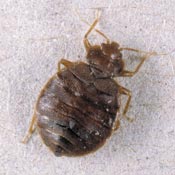Treatment of bed bugs and eradication

bed bugs – Cimex lectularius
Bedbugs belong to the order of insects Hemiptera. Insects such as aphids, scale insects and leaf hoppers also belong to this order. All have sharp piercing mouthparts to take sap from plants. The bedbug however has evolved to take blood from warm-blooded animals which causes irritation. This the main reason why bed bugs are controlled.
The Bed bug (Cimex lectularius) is a flat round insect, is about 6mm long and changes from pale brown to a red brown depending on when it last had a meal. They only exhibit a pair of remnant forewings and they cannot fly. Wen they have fed their segments on the dorsal side expand and take on a oval appearance.
Bed bugs are nocturnal and only feed at night, on exposed areas such as the shoulders and face. Feeding takes about 10 minutes in which they can consume 7 times their body weight in blood. However they can withstand starvation for up to a year.
Fertilized females lay up to 200 eggs in batches of 4-5, if breeding conditions are right. Welding them to surface with a special adhesive. Temperatures above 10 ℃ are required for breeding. After hatching the nymphs go through a series of moults before maturity. This process depends on temperature and the presence of food supplies.
Were do bed bugs live?
Bed bugs live and hide during the day in crevices and cracks nearby or inside the bed frame around the sleeping area of the host. The flat shape of bed bugs allows them to hide in spaces that are a fraction of a mm wide.
Hotels and hostels are often at increased risk of infestations, because of travelers who introduce bedbugs from elsewhere. Bed bugs are wrongly associated with squalor, but nothing could be further from the truth: Clean and well managed establishments are equally affected by bed bugs. Bed bugs produce a characteristic sweet, pungent smell from their scent glands and droppings if the level of infestation is high. They do not transmit diseases and their irritation caused by biting for a blood meal is the main reason for control.
Methods of bed bug extermination
The control of bed bug infestations is multifaceted. A thorough survey of premises and possible harborage sites is an essential part of an effective eradication programme. It starts with the treatment of bed sheets and blankets which should be encased in heat resistant plastic bags and treated in a tumble dryer on a high heat setting (~60 ℃) for half an hour. This will kill bed-bugs present. Bed bugs can remain submerged for over an hour without any effect. Normal washing is not enough to kill bed bugs. The eradication within the room usually consists of application of a strong insecticide such as residual alpha-cypermethrin formulations combined with a growth regulator. However resistance to these insecticides is now widespread and close monitoring and switching to a carbamate based formulation might be necessary.
Other measures, to prevent bedbugs appearing and biting include the use of bedding encasement systems. This is scientifically proven to prevent bedbug entry and exit. In addition this protective barrier is also breathable, waterproof and also prevents exposure to dust mite related allergens. We have these casing systems available, so please contact us for further information.
Further reading: See NHS Bedbug information on bites, treatments and prevention.
